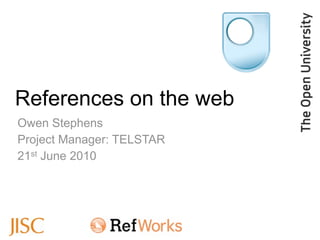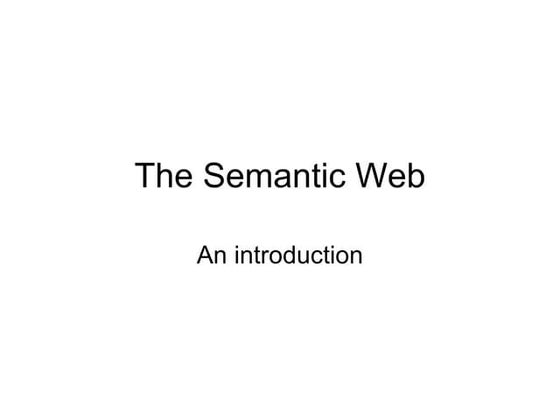References on the web
- 1. References on the web Owen Stephens Project Manager: TELSTAR 21st June 2010
- 2. citations 1
- 3. references 1. Stephens, Owen (2010), References on the Web, [online], Available from: http:// slideshare.net/ostephens (Accessed 21 June 2010)
- 4. hyperlinks
- 5. Scholarly HTML http://ptsefton.com/2009/03/31/scholarly-html.htm ŌĆ£Dead simple reference management via links to trusted sourcesŌĆØ www.open.ac.uk/telstar/
- 6. Scholarly HTML http://ptsefton.com/2009/03/31/scholarly-html.htm ŌĆ£just use a DOI ŌĆō the publisher can be responsible to fetching the metadata and making a bibliography. ŌĆØ www.open.ac.uk/telstar/
- 7. Scholarly HTML http://ptsefton.com/2009/03/31/scholarly-html.htm ŌĆ£let the user choose the referencing style and select it on the flyŌĆØ www.open.ac.uk/telstar/
- 8. Scholarly HTML http://ptsefton.com/2009/03/31/scholarly-html.htm ŌĆ£let readers import the references into their own librariesŌĆØ www.open.ac.uk/telstar/
- 9. Embedding References ŌĆó Identifier + fetch mechanism ŌĆó COinS and OpenURL ŌĆó Microformats ŌĆó JSON ŌĆó RDF/RDFa www.open.ac.uk/telstar/
- 10. doi:10.1109/ISSTA.2002.1048560 www.open.ac.uk/telstar/
- 14. <span class="Z3988" title="ctx_ver=Z39.88-2004 & rft_val_fmt=info%3Aofi%2Ffmt%3A kev%3Amtx%3Ajournal &rft.issn=0028-0836"></span> www.open.ac.uk/telstar/
- 16. hCitation www.open.ac.uk/telstar/
- 17. <span class="monograph"> <a name="sr06"> <span class="author firstauthor"> <span class="family-name" style="font- variant: small-caps; ">Miller</span> <span class="given-name">Michael</span> </span> (<span class="year">2006</span>): <span style="font-style: italic; "> <span class="title">Students' Jokes</span> <span class="place">M├╝nchen</span> : <span class="publisher">Weltbild</span> </a></span> www.open.ac.uk/telstar/
- 19. var publist = [ {"refid":"1","articletype":"article", "title":"Storage of electrons and holes in self-assembled InAs quantum dots","year":"1999","author":"M. C. Bodefeld, R. J. Warburton, K. Karrai, J. P. Kotthaus, G. Medeiros-Ribeiro and P. M. Petroff", "journal":"APPLIED PHYSICS LETTERSŌĆ£, "volume":"74","number":"4"}] www.open.ac.uk/telstar/
- 20. <rdf> www.open.ac.uk/telstar/
- 21. Jane Eyre has a creator whose name is Charlotte Bronte
- 22. Jane Eyre Subject has a creator whose name is Charlotte Bronte
- 23. Jane Eyre Subject has a creator Predicate whose name is Charlotte Bronte
- 24. Jane Eyre Subject has a creator Predicate whose name is Charlotte Bronte Object
- 25. Book Person is a Jane Eyre has publisher is a has creator Penguin Charlotte Bronte
- 26. Book Person is a Jane Eyre has publisher is a has creator Penguin Charlotte Bronte
- 27. Book Person is a Jane Eyre has publisher is a has creator Penguin Charlotte Bronte
- 28. Book Person is a Jane Eyre has publisher is a has creator Penguin Charlotte Bronte
- 29. Book Person is a Jane Eyre has publisher is a has creator Penguin Charlotte Bronte
- 30. bibliontolgy www.open.ac.uk/telstar/
- 31. <rdfa> www.open.ac.uk/telstar/
- 32. <div typeof="foaf:Document"> <dl> <dd class="Pub"> <span class="Title" property="dc:title">Conceptual Framework for Recommendation System Based on Distributed User Ratings</span><br /> <span class="Author" property="dc:creator">H. J. Kim and J. J. Jung and G. S. Jo</ span><br /> <span class="Journal">LECTURE NOTES IN COMPUTER SCIENCE</span>   <span class="Volume"></span>   <span class="Pages">115--122</span>   (<span class="Date" property="dc:date">2004 </span>)<br /> www.open.ac.uk/telstar/
- 34. Look out for ŌĆ” ŌĆó HTML META tags ŌĆó Wikipedia templates ŌĆó Twitter Annotations www.open.ac.uk/telstar/
Editor's Notes
- #11: ISBN; ISSN; DOI; URI - unique identifier Pros No special skills for authors Clarity Full descriptions can be held in appropriate systems No messy stuff in the HTML Cons Some Identifiers are not perfect Not all items have identifiers (although this can be Not all identifiers &#x2018;resolvable&#x2019; Error prone
- #14: OpenURL general framework However, only real use is for (mainly) bibliographic material &#x2013; books, chapters, articles Was originally introduced because of &#x2018;appropriate copy&#x2019; problem OpenURLs made up of &#x2018;resolver address&#x2019; and context object. Works well in dynamic page with user context (e.g. bib database) but not so well on open web Hence COinS &#x2013; Context Object in Span Pros: Well established in libraries, already used by Zotero and others to extract metadata Metadata in the page &#x2013; stands alone Links into resolvers Doesn&#x2019;t require identifier, but can exploit them if they are available Backwards compatible &#x2013; wide range of browsers Cons: Someone has to create the COinS Lack of takeup outside library sector OpenURL is long and ugly standard &#x2013; tends to be disliked by implementers!
- #16: Summary of Microformats &#x2013; way of embedding structured data into web pages Microformats &#x2013; build on existing standards to enable you to embed &#x2018;semantics&#x2019; into XHTML Specifically hCard and hCalendar have proved popular Example http://www.ukoln.ac.uk/web-focus/events/workshops/webmaster-2006/sessions/kelly/ Pros Combine human readable and computer readable versions of data &#x2013; no duplication Metadata in the page &#x2013; stands alone Doesn&#x2019;t require identifier Backwards compatible to any XHTML Cons: Mixes human readable and computer readable versions of data &#x2013; leads to confusion, and more complex data structures Lack of take-up of microformats excepting hCard and hCalendar Possible accessibility issues (re BBC decision to drop hCalendar) No &#x2018;use case&#x2019; (unlike COinS) As far as I know not consumed by existing tools (e.g. Zotero)
- #17: Pros Combine human readable and computer readable versions of data &#x2013; no duplication Metadata in the page &#x2013; stands alone Doesn&#x2019;t require identifier Backwards compatible to any XHTML Cons: Mixes human readable and computer readable versions of data &#x2013; leads to confusion, and more complex data structures Lack of take-up of microformats excepting hCard and hCalendar - is hCitation going anywhere? Possible accessibility issues (re BBC decision to drop hCalendar) No &#x2018;use case&#x2019; (unlike COinS) As far as I know not consumed by existing tools (e.g. Zotero)
- #19: Javascript JSON (Javascript Notation) MARC-JSON BibJSON http://www.bibkn.org/bibjson/index.html CSL example http://serials.infomotions.com/code4lib/archive/2010/201004/1203.html CSL Citeproc-js
- #20: Pros: (seen as) simple in-line styling Separates display elements from data CSL Cons: Essentially a variation on use of identifier No well-established schema Not a single type of data
- #21: RDF is &#x2018;Resource Description Framework&#x2019;
- #35: RDFa &#x2013; RDF in attributes Enables you to embed RDF statements into web pages Pros Combine human readable and computer readable versions of data &#x2013; no duplication Metadata in the page &#x2013; stands alone Doesn&#x2019;t require identifier Growing number of tools that can extract RDFa &#x2013; Zotero working on it? Part of growing &#x2018;linked data&#x2019; movement Cons: Mixes human readable and computer readable versions of data &#x2013; leads to confusion, and more complex data structures No widespread takeup yet &#x2013; although some significant uses (e.g. O&#x2019;Reilly) Requires new doc type = XHTML+RDFa
- #36: RDFa &#x2013; RDF in attributes Enables you to embed RDF statements into web pages
- #38: Goes beyond just describing the resource Describes the way in which it is being used



![references
1. Stephens, Owen (2010), References on
the Web, [online], Available from: http://
slideshare.net/ostephens (Accessed 21
June 2010)](https://image.slidesharecdn.com/telstarirm22010-06-21-100621085413-phpapp01/85/References-on-the-web-3-320.jpg)















![var publist = [
{"refid":"1","articletype":"article",
"title":"Storage of electrons and holes
in self-assembled InAs quantum
dots","year":"1999","author":"M. C.
Bodefeld, R. J. Warburton, K. Karrai,
J. P. Kotthaus, G. Medeiros-Ribeiro and
P. M. Petroff",
"journal":"APPLIED PHYSICS LETTERSŌĆ£,
"volume":"74","number":"4"}]
www.open.ac.uk/telstar/](https://image.slidesharecdn.com/telstarirm22010-06-21-100621085413-phpapp01/85/References-on-the-web-19-320.jpg)




















































